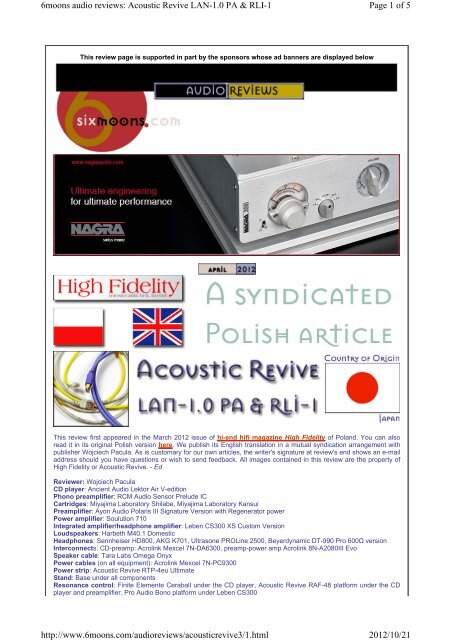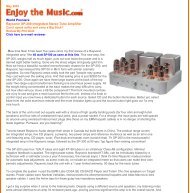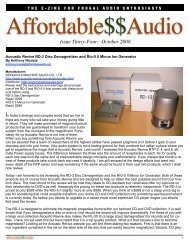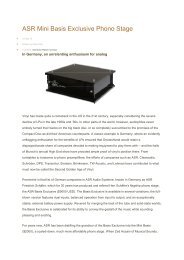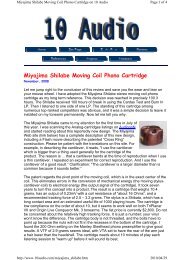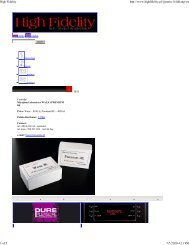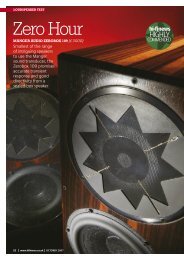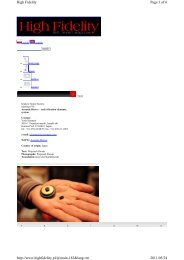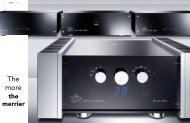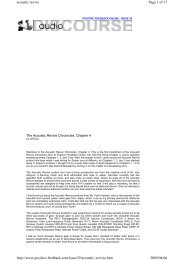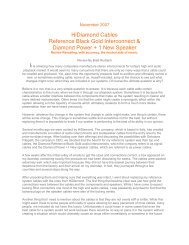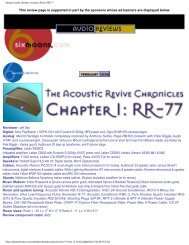Acoustic Revive LAN- 1.0 PA & RLI-1 Review by 6moons
Acoustic Revive LAN- 1.0 PA & RLI-1 Review by 6moons
Acoustic Revive LAN- 1.0 PA & RLI-1 Review by 6moons
Create successful ePaper yourself
Turn your PDF publications into a flip-book with our unique Google optimized e-Paper software.
<strong>6moons</strong> audio reviews: <strong>Acoustic</strong> <strong>Revive</strong> <strong>LAN</strong>-<strong>1.0</strong> <strong>PA</strong> & <strong>RLI</strong>-1http://www.<strong>6moons</strong>.com/audioreviews/acousticrevive3/1.htmlPage 1 of 52012/10/21This review page is supported in part <strong>by</strong> the sponsors whose ad banners are displayed belowThis review first appeared in the March 2012 issue of hi-end hifi magazine High Fidelity of Poland. You can alsoread it in its original Polish version here. We publish its English translation in a mutual syndication arrangement withpublisher Wojciech Pacula. As is customary for our own articles, the writer's signature at review's end shows an e-mailaddress should you have questions or wish to send feedback. All images contained in this review are the property ofHigh Fidelity or <strong>Acoustic</strong> <strong>Revive</strong>. - Ed<strong>Review</strong>er: Wojciech PaculaCD player: Ancient Audio Lektor Air V-editionPhono preamplifier: RCM Audio Sensor Prelude ICCartridges: Miyajima Laboratory Shilabe, Miyajima Laboratory KansuiPreamplifier: Ayon Audio Polaris III Signature Version with Regenerator powerPower amplifier: Soulution 710Integrated amplifier/headphone amplifier: Leben CS300 XS Custom VersionLoudspeakers: Harbeth M40.1 DomesticHeadphones: Sennheiser HD800, AKG K701, Ultrasone PROLine 2500, Beyerdynamic DT-990 Pro 600Ω versionInterconnects: CD-preamp: Acrolink Mexcel 7N-DA6300, preamp-power amp Acrolink 8N-A2080III EvoSpeaker cable: Tara Labs Omega OnyxPower cables (on all equipment): Acrolink Mexcel 7N-PC9300Power strip: <strong>Acoustic</strong> <strong>Revive</strong> RTP-4eu UltimateStand: Base under all componentsResonance control: Finite Elemente Ceraball under the CD player, <strong>Acoustic</strong> <strong>Revive</strong> RAF-48 platform under the CDplayer and preamplifier. Pro Audio Bono platform under Leben CS300
<strong>6moons</strong> audio reviews: <strong>Acoustic</strong> <strong>Revive</strong> <strong>LAN</strong>-<strong>1.0</strong> <strong>PA</strong> & <strong>RLI</strong>-1http://www.<strong>6moons</strong>.com/audioreviews/acousticrevive3/1.htmlPage 2 of 52012/10/21<strong>Review</strong> component retail in Poland: zł 1.190 for 1m cable, zł 1.190 for filterHaters impossible, unite. This review is for you. And may you have a good laugh. Please. This is about the sonicinfluence of a <strong>LAN</strong> cable and isolator (the latter known from medical products). The Japanese <strong>Acoustic</strong> <strong>Revive</strong>company has introduced two new products to the market – the <strong>LAN</strong>-<strong>1.0</strong> <strong>PA</strong> cable and <strong>RLI</strong>-1 isolator. These are aimedat improving systems whose source is a network player with music files stored on a server or network drive. Feel freeto laugh now and get it over with. Because then we can tackle a serious matter. If somebody had told me a few yearsago that I would be reviewing <strong>LAN</strong> cables, I too would have smiled. Perhaps without malice because I’m used toaccepting how little is known (and how little I know) about the mechanisms of sound reproduction - but I would havesmiled with some distrust. My changed attitude shows that on one hand I really know little about the nature of signaltransmission, on the other hand how big of a leap playback quality over a network has made.What is a <strong>LAN</strong> cable used for? To transmit digital signals in so-called packets over a local area network. Commonsense would lead to the conclusion that adherence to a few basic rules—a good CAT-5e cable with clean qualitycontacts etc— would eliminate any sonic influence across this bit of the signal path. Yet it doesn’t.
<strong>6moons</strong> audio reviews: <strong>Acoustic</strong> <strong>Revive</strong> <strong>LAN</strong>-<strong>1.0</strong> <strong>PA</strong> & <strong>RLI</strong>-1http://www.<strong>6moons</strong>.com/audioreviews/acousticrevive3/1.htmlPage 3 of 52012/10/21My first introduction to this subject came from the man who spent the last two years researching digital transmissionand the interaction of a network player with a local area network including NAS and servers. I am talking aboutGerhard Hirt and his networked Ayon Audio S-3 player. Gerhard collaborated on his player with one of the best teamsfor this task, StreamUnlimited from Vienna. That’s a group of Austrian and American engineers who worked for Philipsand during the late 70s designed the mechanical drives for CD players which eventually led to the CD Pro-2. Afterstarting their own company they designed and built the world’s first music server. Now they specialize in CD andDVD/BD drives as well as central processing units for file players. Their modules are used <strong>by</strong> companies like MusicalFidelity, Audio Research, Pro-Ject and Ayon Audio.During our meeting Gerhard told me how it had taken their team a long time to understand why the sound of the playerwas far worse when files were played from a pen drive plugged into the USB port and much better when the signal
<strong>6moons</strong> audio reviews: <strong>Acoustic</strong> <strong>Revive</strong> <strong>LAN</strong>-<strong>1.0</strong> <strong>PA</strong> & <strong>RLI</strong>-1http://www.<strong>6moons</strong>.com/audioreviews/acousticrevive3/1.htmlPage 4 of 52012/10/21arrived via <strong>LAN</strong> from a server. They came to the same conclusions the Linn people did some time ago - <strong>LAN</strong> allows formuch better clock synchronization between network player and network file storage. I don’t know whether youremember but for a long time—perhaps until today—Linn did purposely not include any USB ports in their players. Thesignal always entered via <strong>LAN</strong> port.My second motivator on the subject came from another person related to audio technology whilst at the same timebeing the HifiCritic’s editor, Malcolm Steward. In his article Build Your Own NAS he described his experiences witheSATA cables and how their different versions influenced the data transfer (Malcolm Steward, The Infamous SATACable Saga in Build Your Own NAS, HifiCritic, October/November/December 2011, Vol5, No4, s. 23). Such revelationsabout digital data which shouldn’t care about the method of their transfer made manufacturers rethink the role of the<strong>LAN</strong> cable in audio systems. Thus a lot of specialized cables came into existence which can be found in thecatalogues of Supra and many others, including <strong>Acoustic</strong> <strong>Revive</strong>. The latter designed today’s <strong>LAN</strong>-<strong>1.0</strong> (the two-meterversion is called <strong>LAN</strong>-2.0) and a low-pass filter which cleans the <strong>LAN</strong> network from HF interference. Such filters arestandard for medical devices where high performance and low distortion are top priority. They are simple isolationtransformers. <strong>Acoustic</strong> <strong>Revive</strong> examined their influence on the sound and claim that using just the transformersdiminished dynamics whereas adding some coils and rearranging the filter circuit much improved it. Thus the <strong>RLI</strong>-1filter was born. It plugs between router and server or router and player or better yet, both.
<strong>6moons</strong> audio reviews: <strong>Acoustic</strong> <strong>Revive</strong> <strong>LAN</strong>-<strong>1.0</strong> <strong>PA</strong> & <strong>RLI</strong>-1http://www.<strong>6moons</strong>.com/audioreviews/acousticrevive3/1.htmlPage 5 of 52012/10/21


